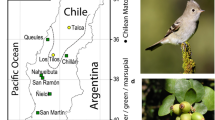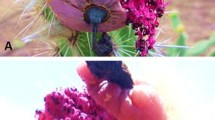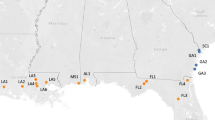Abstract
A number of fleshy-fruit-bearing plants of temperate regions are dispersed by migratory frugivorous birds. It has been suggested that the more southerly populations of such species should produce ripe fruits later than more northerly populations, to ensure that fruit is available when the birds arrive. I will call this the ‘adaptive delay’ hypothesis. To test this hypothesis, I monitored fruiting phenology of Crataegus monogyna Jacq. at ten sites (in all of which fruit consumption is very largely by redwings, Turdus iliacus, and fieldfares, Turdus pilaris) between northern Spain (42° N) and northern Scotland (59° N). There was no negative correlation between latitude and date of fruit ripening (earliest recorded date on which ripe fruits had appeared, or earliest recorded date by which all fruits had ripened). My results thus argue against the adaptive delay hypothesis.
Similar content being viewed by others
References
Da Prato, S., Da Prato, E. & Chittenden, D. 1980. Redwing migration through the British Isles. Ringing Migration 3: 9-20.
Debussche, M. & Isenmann, P. 1992. A mediterranean bird disperser assemblage: composition and phenology in relation to fruit availability. Rev. Ecol. (Terre Vie) 47: 411-432.
Fisher, D. V. 1962. Heat units and number of days required to mature some pome and stone fruits in various areas of North America. Proc. Am. Soc. Horticultural Sci. 80: 114-124.
Fuentes, M. 1992. Latitudinal and elevational variation in fruiting phenology among western European bird-dispersed plants. Ecography 15: 177-183.
Gorchov, D. 1987. Sequence of fruit ripening in bird-dispersed plants: consistency among years. Ecology 69: 223-225.
Gorchov, D. 1990. Pattern, adaptation, and constraint in fruiting synchrony within vertebrate-dispersed woody plants. Oikos 58: 169-180.
Lacey, E. P. 1982. Timing of seed dispersal in Daucus carotaL. (Apiaceae). Oikos 39: 83-91.
Primack, R. B. 1985. Patterns of flowering phenology in communities, individuals, and single flowers. Pp. 571-593. In: White, J. (ed.), The population structure of vegetation. Junk, Dordrecht.
Santos, T. 1982. Migración e invernada de zorzales y mirlos (Genero Turdus)en la Península Ibérica. Doctoral thesis. Univ. Complutense, Madrid.
Slade, N. A., Horton, J. S. & Mooney, H. A. 1975. Yearly variation in the phenology of California annuals. Am. Mid. Nat. 94: 209- 214.
Snow, D.W. 1971. Evolutionary aspects of fruit-eating by birds. Ibis 113: 194-202.
Snow, B. & Snow, D. 1988. Birds and berries. T. & A.D. Poyser, Waterhouses, England.
Stiles, E.W. 1980. Patterns of fruit presentation and seed dispersal in bird-disseminated woody plants in the eastern deciduous forest. Am. Nat. 116: 670-688.
Author information
Authors and Affiliations
Rights and permissions
About this article
Cite this article
Guitián, P. Latitudinal variation in the fruiting phenology of a bird-dispersed plant (shape Crataegus monogyna) in Western Europe. Plant Ecology 137, 139–142 (1998). https://doi.org/10.1023/A:1009712000104
Issue Date:
DOI: https://doi.org/10.1023/A:1009712000104




